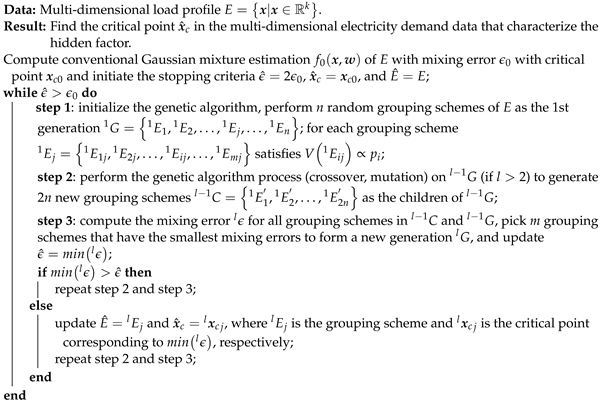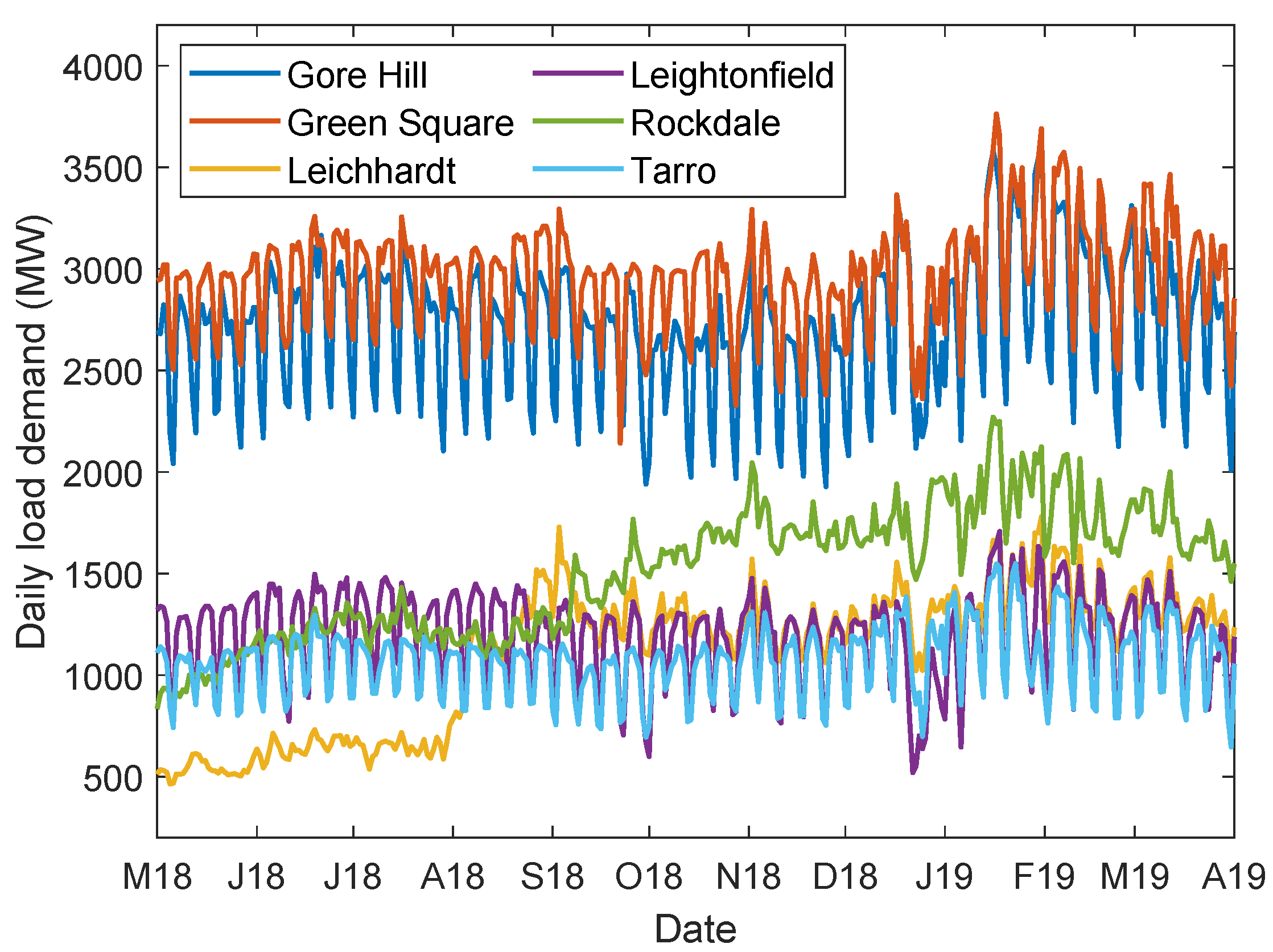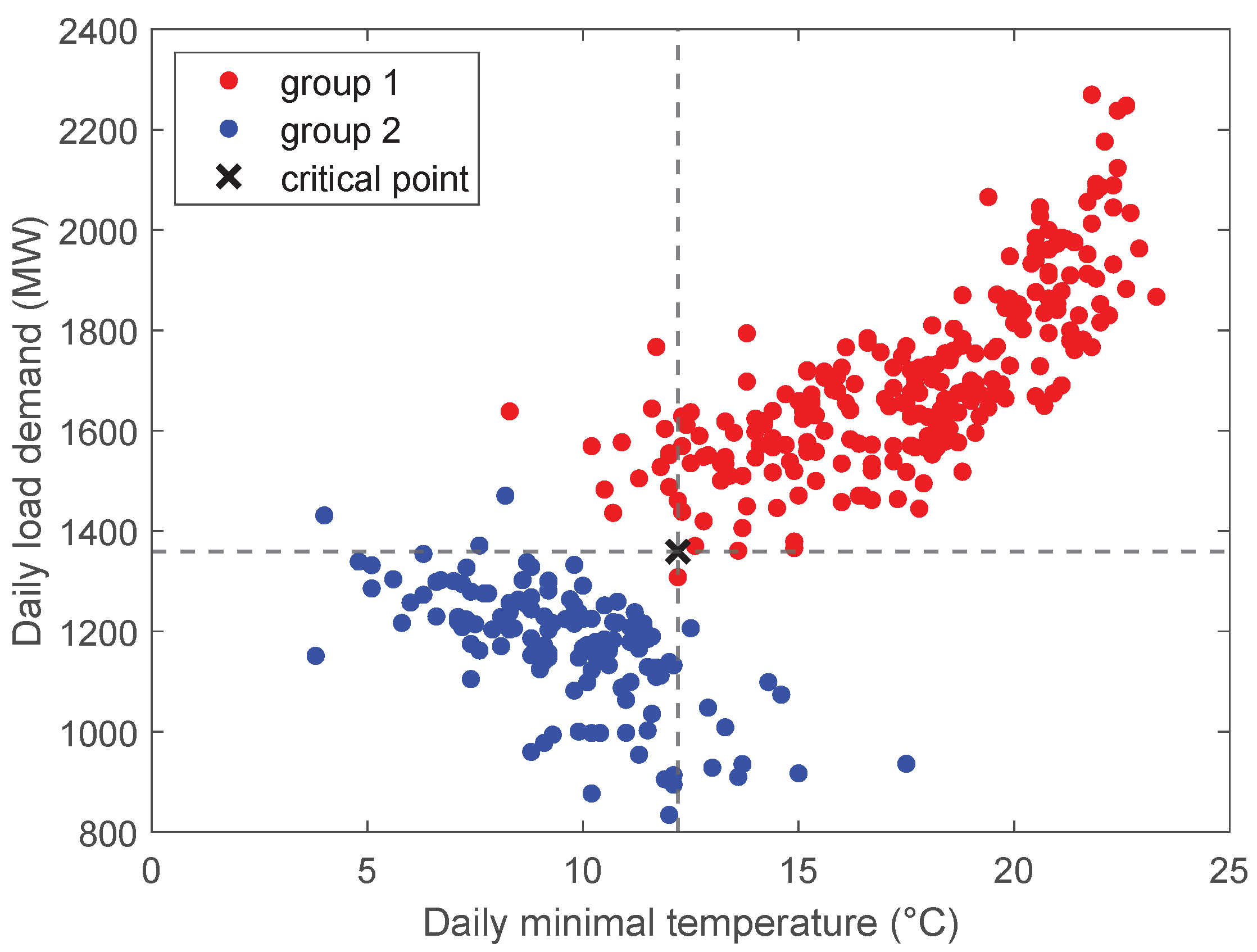Uncovering Hidden Factors in Electricity Consumption Based on Gaussian Mixture Estimation
Abstract
:1. Introduction
- A GMM-based residential load characterization method is proposed, which efficiently assesses the hidden factors in the residential load from real-world and synthesized data set.
- A new metric, mixture error, is proposed, which is able to handle the uncertainty in the residential load.
- The proposed method considers various specific properties of the multidimensional load data.
2. Proposed Method
2.1. Multimodal Distribution and Mixing Error
2.2. Multi-Dimensional Load Profile
2.3. Uncover the Hidden Factors
| Algorithm 1: Uncovering hidden factor from multi-dimensional load profile. |
 |
3. Case Studies
3.1. The Hidden Factor of Household Population
3.2. The Hidden Factor of Temperature
4. Conclusions
Author Contributions
Funding
Institutional Review Board Statement
Informed Consent Statement
Data Availability Statement
Conflicts of Interest
References
- Gaur, K.; Kumar, H.; Agarwal, R.P.K.; Baba, K.V.S.; Soonee, S.K. Analysing the electricity demand pattern. In Proceedings of the 2016 National Power Systems Conference (NSC), Bhubaneswar, India, 19–21 December 2016; pp. 1–6. [Google Scholar]
- Su, W.; Huang, A.Q. Energy Internet: An Open Energy Platform to Transform Legacy Power Systems into Open Innovation and Global Economic Engine; Woodhead Publishing: Cambridge, UK, 2018. [Google Scholar]
- Chen, T.; Alsafasfeh, Q.; Pourbabak, H.; Su, W. The next-generation retail electricity market with customers and prosumers—A bibliographical survey. Energies 2018, 11, 8. [Google Scholar] [CrossRef] [Green Version]
- Su, W.; Wang, J.; Ton, D. Smart grid impact on operation and planning of electric energy systems. In Handbook of Clean Energy Systems; Yan, J., Ed.; Wiley: Hoboken, NJ, USA, 2015. [Google Scholar]
- Yuan, Y.; Dehghanpour, K.; Bu, F.; Wang, Z. A Data-Driven Customer Segmentation Strategy Based on Contribution to System Peak Demand. IEEE Trans. Power Syst. 2020, 35, 4026–4035. [Google Scholar] [CrossRef] [Green Version]
- Bu, F.; Dehghanpour, K.; Yuan, Y.; Wang, Z.; Guo, Y. Disaggregating Customer-Level Behind-the-Meter PV Generation Using Smart Meter Data and Solar Exemplars. IEEE Trans. Power Syst. 2021, 36, 5417–5427. [Google Scholar] [CrossRef]
- Liao, S.; Wei, L.; Kim, T.; Su, W. Modeling and Analysis of Residential Electricity Consumption Statistics: A Tracy-Widom Mixture Density Approximation. IEEE Access 2020, 8, 163558–163567. [Google Scholar] [CrossRef]
- Schilling, M.F.; Watkins, A.E.; Watkins, W. Is human height bimodal? Am. Stat. 2002, 56, 223–229. [Google Scholar] [CrossRef]
- LoadProfileGenerator. Available online: https://www.loadprofilegenerator.de/ (accessed on 7 July 2020).
- Pflugradt, N. Modellierung von Wasser und Energieverbräuchen in Haushalten. Ph.D. Dissertation, Technischen Universität Chemnitz, Chemnitz, Germany, 2016. [Google Scholar]



Publisher’s Note: MDPI stays neutral with regard to jurisdictional claims in published maps and institutional affiliations. |
© 2022 by the authors. Licensee MDPI, Basel, Switzerland. This article is an open access article distributed under the terms and conditions of the Creative Commons Attribution (CC BY) license (https://creativecommons.org/licenses/by/4.0/).
Share and Cite
Liao, S.; Wei, L.; Su, W. Uncovering Hidden Factors in Electricity Consumption Based on Gaussian Mixture Estimation. Energies 2022, 15, 319. https://doi.org/10.3390/en15010319
Liao S, Wei L, Su W. Uncovering Hidden Factors in Electricity Consumption Based on Gaussian Mixture Estimation. Energies. 2022; 15(1):319. https://doi.org/10.3390/en15010319
Chicago/Turabian StyleLiao, Shiwen, Lu Wei, and Wencong Su. 2022. "Uncovering Hidden Factors in Electricity Consumption Based on Gaussian Mixture Estimation" Energies 15, no. 1: 319. https://doi.org/10.3390/en15010319
APA StyleLiao, S., Wei, L., & Su, W. (2022). Uncovering Hidden Factors in Electricity Consumption Based on Gaussian Mixture Estimation. Energies, 15(1), 319. https://doi.org/10.3390/en15010319







